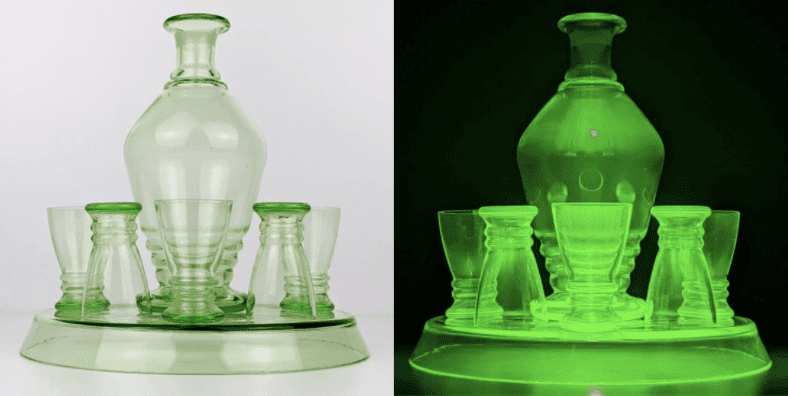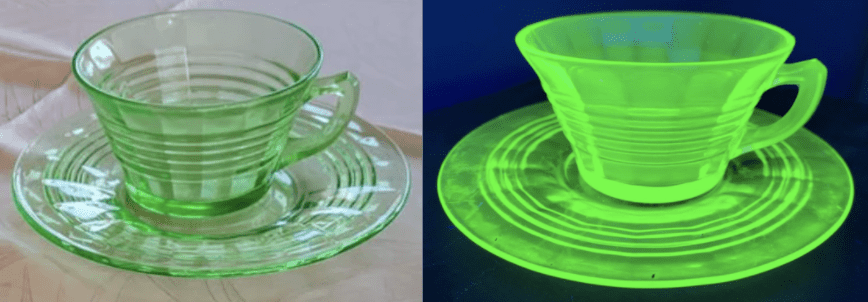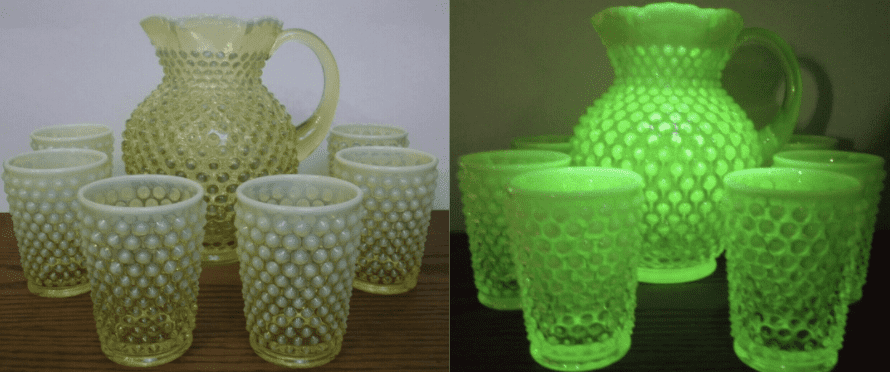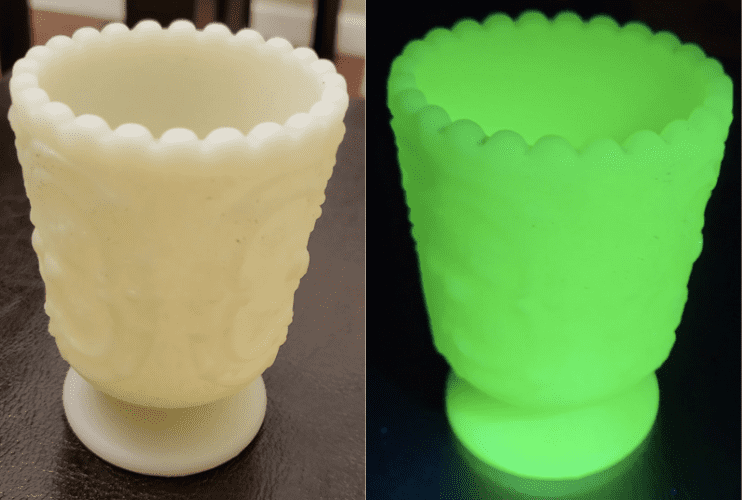Uranium glass is a general term that encompasses a few types of glass. It was first invented in the 1830s and is still produced today.
Uranium glass is made using uranium coloring. A small amount of uranium is mixed into the molten glass. The result is glass that is tinted yellow or green and glows under UV light. This interesting effect is why uranium was a common addition in glassware for almost two centuries.
Uranium glass has many different types, and it has a fascinating history. There are a lot of things to know about uranium glass.

How Is Uranium Glass Made?
To make uranium glass, uranium salt is added to the molten glass before it is shaped and solidified. The salt can withstand temperatures of almost 2000 degrees Fahrenheit, which makes it perfect for creating glass. The amount of uranium salt added determines the color of the glass. The color can also be changed by additives, such as metals or different glass compositions. (Source)
Many types of glassware were made from uranium glass. There are uranium glass vases, candlesticks, and even dishware, though eating from, or storing food in, uranium glass is not advisable. Jewelry, figurines, and bottles have also been made from uranium glass. Some special uses of uranium glass in history were for ultra-violet absorbing glasses, darkroom window glass, electric light bulbs, egg cups, and tobacco pipes (Source).

What Is Special about Uranium Glass?
The various colors of uranium glass and its special glow make this glassware different and unique from the normal glass that is commonly used today. There are multiple kinds of uranium glass, and each is special in a different way.
Vaseline glass is the most commonly recognized type of uranium glass. This type is translucent and tinted yellow or light green (Source). Vaseline glass is usually yellow or yellow-green, but creators often added iron-oxide to the mixture to create a richer green color that was more appealing to customers and sold much better. This glass is not considered true Vaseline glass (Source).

Vaseline glass can have different definitions in different countries. Australians use the term to mean a type of glass that has an opalescent rim; what Americans refer to as Vaseline glass, they call citron glass. In Britain, it refers to wispy opalescent glass. In Germany, all uranium glass is called “uranglas.” (Source).
Custard Glass
Unlike Vaseline glass, Custard glass is opaque. It was often used to make vases. The color is typically a glossy white with a slightly green or yellow tint. Many pieces made of custard glass were embellished with other types of glass in the shape of plant life (flowers, leaves, etc.). A layer of another type of glass is often present on the inside of the piece, often pink in color. (Source)

Burmese Glass
Burmese glass is also opaque, but it is light yellow at the bottom and fades into a salmon color at the top. It was popular in the Victorian Era. It was produced and mostly bought in the United States and the United Kingdom. Many Burmese glass pieces were hand-painted with flowers or animals. Most pieces of Burmese glass have been treated to have a matte finish; untreated pieces have a glossy finish. (Source)

Radioactivity
The radioactive properties of uranium were not discovered until 1866 after it was used in glass for more than 30 years (Source). Despite that, few regulations were put on its use until 1894; before that, it was commonly used for healing effects and put into medicines. Uranium isotopes are radioactive. As uranium decays, it emits alpha or beta particles, as well as gamma radiation (Source).
The radioactivity of uranium glass is low and will have little effect on people. The level of radiation is not higher than that of the natural radiation we experience on a daily basis (Source). Nevertheless, the United States Environmental Protective Agency recommends that owners of uranium glass do not break, store food in, or try to dispose of uranium glass (Source). Try to avoid prolonged direct exposure to uranium glass.
Why did People Put Uranium in Glass?
The first known production of uranium glass was in 1831 at the Prague Exhibition. It was commonly created in France, Germany, Austria, Sweden, and Italy. Different countries tended to produce different colors or types of pieces of uranium glass. England began to produce their own around World War I because the country could no longer purchase it from Germany. Uranium was also used in glazes and enamels. (Source)
The production of it gained popularity in the 1880s. In the 1940s, the United States government limited the use of uranium in a non-military capacity. In 1959, companies began making uranium glass using the more available depleted uranium. Uranium glass was produced in Asia from the late 19th century to the mid-20th century; it was primarily produced in Japan. (Source)
Back in the day, glass manufacturers added uranium to their glassware because of the interesting effect the uranium had on the glass. If you put uranium glass under UV light, it will glow green.

If you don’t have a UV light, the color can still be used to identify uranium glass; uranium glass tends to have a green or yellow tint, whether the glass is opaque or translucent. However, there are some types of glass that do not contain uranium that produce similar effects, and there are types of uranium glass that, because of additives and uranium levels, are a different color. (Source)
The radiation can be measured to determine whether a piece is uranium glass, though this is often not necessary and harder to achieve. The amount of radiation can also be measured to date the uranium glass. (Source)
Value
Antique uranium glassware can be worth a lot of money. The value of a piece depends highly on where, when, and how it was made. The value can also depend on the condition of the piece. If it has scratches or chips or has been repaired, it is not going to be worth as much. (Source)
Be careful when buying uranium glass. Some people will try to sell you products that have similar characteristics to uranium glass, but that are not worth as much (Source). Make sure to have a professional check the authenticity of a piece.

Modern Day Production
Uranium glass is still made to this day, however, the production is much more limited. It is mostly created for artistic or scientific purposes. Pieces of uranium glass created more recently tend to not be worth as much as antiques.

